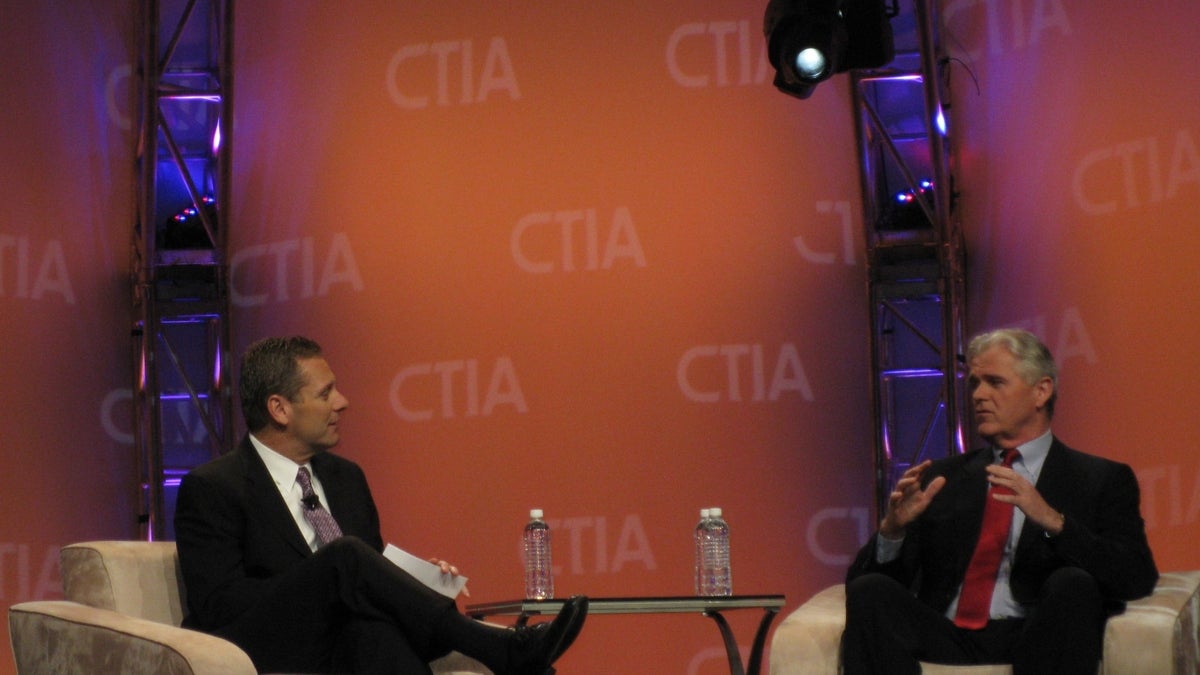Sprint, Clearwire CEOs ponder LTE for future
Company execs take the stage at CTIA and admit they can foresee using a competing technology in future network upgrades.

LAS VEGAS--Sprint Nextel and Clearwire executives admitted Wednesday that they could follow the rest of the worldwide wireless network and adopt LTE for future network upgrades.
Spring Nextel CEO Dan Hesse and Clearwire CEO Bill Morrow sat down separately and talked to CTIA CEO Steve Largent during the keynote session on the second day of the CTIA trade show here.
In 2008, Sprint and Clearwire combined spectrum and formed a partnership to build a nationwide network using a technology called WiMax. During the keynote conversations, Largent asked each executive about his company's decision to use WiMax over other technologies, such as LTE, or Long Term Evolution. Today, most of the world's wireless carriers, including fellow CDMA carrier Verizon Wireless plan to use LTE to build their next generation wireless networks.
Hesse admitted that LTE will be the dominant technology throughout the world when it comes to 4G wireless. But he said Sprint could add LTE down the road when it needs to upgrade to 5G wireless.
"Because of our spectrum position, we can always add other technologies later," he said.
While Hesse said he believes in WiMax, he said the decision to use that technology was all about time to market.
"WiMax was tried-and-true tested technology at the time we made the choice," he said. "And we thought we could go with that for 4G now or wait for another technology that would be ready later. And we couldn't wait."
Clearwire's CEO Bill Morrow gave the same explanation.
"We started with the technology that was available at the time," he said.
Indeed, time to market is critical in the ultracompetitive U.S. wireless market. Sprint and Clearwire are the first companies to offer 4G wireless broadband services to customers in the U.S. And they are at least a year ahead of competitors such as Verizon Wireless, which is building its network now and expects to launch in 25 to 30 markets by the end of 2010.
Clearwire, which is building the network with the help of money from other investors--including cable operators Comcast and Time Warner, as well as chip maker Intel and Internet giant Google--already has service up and running in 27 markets.
Clearwire plans to expand the network to a slew of new markets in 2010, including New York City, Boston, and the San Francisco Bay Area. In February, the company said it covered about 30 million potential customers, but by the end of the year, it expects to be able to provide 4G wireless access to 120 million potential customers.
The service greatly improves mobile Internet speeds over current 3G technology. Clearwire has said that customers can expect average download speeds up to 6Mbps and sometimes higher. This is a vast improvement over peak rates of around
To help seed the market and make the service more useful for consumers, Sprint has been announcing new devices that share the 4G wireless connection among several Wi-Fi enabled devices. On Tuesday, Sprint announced the new HTC Evo smartphone, which will be the first 4G wireless and mobile WiMax phone to hit the market. It not only provides faster download speeds for the handset, but the device also acts as a Wi-Fi access point to provide Internet connectivity via Wi-Fi for up to eight devices.
At the Consumer Electronics Show here in January, Sprint announced the Overdrive product, which also acts as a mini Wi-Fi router providing Internet connectivity to Wi-Fi enabled devices via the 4G WiMax connection.
"Wi-Fi changes the way we think about mobile devices," Hesse said. "We tend to think of just phones (when we think of mobility), but everything is going to be wireless and mobile."
Leveraging Wi-Fi with the WiMax products is a quick and inexpensive way for Sprint and Clearwire to expand the number of devices that can use the Clearwire WiMax network.
While WiMax is the technology that is being used today for this network, Clearwire's Morrow emphasized that the company was open to adding other technologies if they made sense. He said that Clearwire is technology agnostic.
"We won't fight a technology war," he said. "We can sunset one technology if we need to. We provide customers what they want: access to the network at a low cost. And our network is designed so we can add LTE if we need to."
Morrow said that it's unproductive to pick sides in a technology war, especially since WiMax and LTE are closely related and use the same modulation technology. He said he's already in talks with other service providers who have committed to LTE, such as Vodafone, about working together.
"Rather than getting into camps over technology that overlaps, we have an opportunity to converge here," he said. "Whether it's LTE or WiMax shouldn't matter. We should be thinking of where we can bring together technology to get worldwide scale to benefit the consumers and everyone in the value chain."

